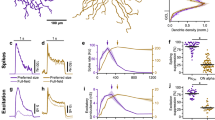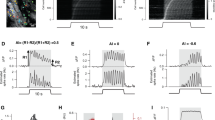Abstract
The function and nature of inhibition of neurons in the visual cortex have been the focus of both experimental and theoretical investigations1,2,3,4,5,6,7. There are two ways in which inhibition can suppress synaptic excitation2,8. In hyperpolarizing inhibition, negative and positive currents sum linearly to produce a net change in membrane potential. In contrast, shunting inhibition acts nonlinearly by causing an increase in membrane conductance; this divides the amplitude of the excitatory response. Visually evoked changes in membrane conductance have been reported to be nonsignificant or weak, supporting the hyperpolarization mode of inhibition3,9,10,11,12. Here we present a new approach to studying inhibition that is based on in vivo whole-cell voltage clamping. This technique allows the continuous measurement of conductance dynamics during visual activation. We show, in neurons of cat primary visual cortex, that the response to optimally orientated flashed bars can increase the somatic input conductance to more than three times that of the resting state. The short latency of the visually evoked peak of conductance, and its apparent reversal potential suggest a dominant contribution from γ-aminobutyric acid ((GABA)A) receptor-mediated synapses. We propose that nonlinear shunting inhibition may act during the initial stage of visual cortical processing, setting the balance between opponent ‘On’ and ‘Off’ responses in different locations of the visual receptive field.
This is a preview of subscription content, access via your institution
Access options
Subscribe to this journal
Receive 51 print issues and online access
$199.00 per year
only $3.90 per issue
Buy this article
- Purchase on Springer Link
- Instant access to full article PDF
Prices may be subject to local taxes which are calculated during checkout




Similar content being viewed by others
References
Sillito, A. M. The contribution of inhibitory mechanisms to the receptive field properties of neurones in striate cortex of the cat. J. Physiol. 250, 305–329 (1975).
Koch, C. & Poggio, T. in Models of the Visual Cortex (eds Rose, D. & Dobson, V. G.) 408–419 (J. Wiley and Sons, Chichester, (1985)).
Douglas, R. J., Martin, K. A. C. & Whitteridge, D. Selective responses of visual cortical cells do not depend on shunting inhibition. Nature 332, 642–644 (1988).
Ferster, D. Spatially opponent excitation and inhibition in simple cells of the cat visual cortex. J. Neurosci. 8, 1172–1180 (1988).
Volgushev, M., Pei, X., Vidyasagar, T. R. & Creutzfeldt, O. D. Excitation and inhibition in orientation selectivity of cat visual cortex neurons revealed by whole-cell recordings in vivo. Vis. Neurosci. 10, 1151–1155 (1993).
Bush, P. C. & Sejnowski, T. J. Effects of inhibition and dendritic saturation in simulated neocortical pyramidal cells. J. Neurophys. 71, 2183–2193 (1994).
Carandini, M. & Heeger, D. J. Summation and division by neurons in primate visual cortex. Science 264, 1333–1336 (1994).
Eccles, J. C. The Physiology of Synapses (Springer, Berlin, (1964)).
Berman, N. J., Douglas, R. J., Martin, K. A. C. & Whitteridge, D. Mechanisms of inhibition in cat visual cortex. J. Physiol. 440, 697–722 (1991).
Ferster, D. & Jagadeesh, B. EPSP-IPSP interactions in cat visual cortex studied with in vivo whole-cell patch recording. J. Neurosci. 12, 1262–1274 (1992).
Carandini, M. & Ferster, D. Atonic hyperpolarization underlying contrast adaptation in cat visual cortex. Science 276, 949–952 (1997).
Pei, X., Volgushev, M., Vidyasagar, T. R. & Creutzfeldt, O. D. Whole-cell recording and conductance measurements in cat visual cortex in vivo. Neuroreport 2, 485–488 (1991).
Hubel, D. H. & Wiesel, T. N. Receptive fields, binocular interaction and functional architecture in the cat's visual cortex. J. Physiol. 160, 106–154 (1962).
Shulz, D., Bringuier, V. & Frégnac, Y. Complex-like structure of simple visual cortical receptive fields is masked by GABAAintracortical inhibition. Soc. Neurosci. Abstr. 19, 638 (1993b).
Koch, C., Douglas, R. & Wehmeier, U. Visibility of synaptically induced conductance changes: theory and simulations of anatomically characterized cortical pyramidal cells. J. Neurosci. 10, 1728–1744 (1990).
Connors, B. W., Malenka, R. C. & Silva, L. R. Two inhibitory postsynaptic potentials and GABAAand GABABreceptor mediated responses in neocortex of rat and cat. J. Physiol. 406, 443–468 (1988).
Berman, N. J., Douglas, R. J. & Martin, K. A. C. The conductances associated with inhibitory postsynaptic potentials are larger in visual cortical neurones in vitro than in similar neurones in intact, anaesthetized rats. J. Physiol. 418, 107 (1989).
Dreifuss, J. J., Kelly, J. S. & Krnjevic, K. Cortical inhibition and gamma-aminobutyric acid. Exp. Brain Res. 9, 137–154 (1969).
Rall, W. in Neural Theory and Modeling (ed. Reiss, R. F.) 73–97 (Stanford Univ., (1964)).
Spruston, N., Jaffe, D. B., Williams, S. H. & Johnston, D. Voltage- and space-clamp errors associated with the measurement of electronically remote synaptic events. J. Neurophys. 70, 781–802 (1993).
1. Palmer, L. A. & Davis, T. A. Receptive field structure in cat striate cortex. J. Neurophys. 46, 260–295 (1981).
Jagadeesh, B., Wheat, H. S. & Ferster, D. Linearity of summation of synaptic potentials underlying direction sleectivity in simple cells of the cat visual cortex. Science 262, 1901–1904 (1993).
Nelson, S., Toth, L., Sheth, B. & Sur, M. Orientation selectivity of cortical neurons during intracellular blockade of inhibition. Science 265, 774–777 (1994).
Barker, J. L. & Harrison, N. L. Outward rectification of inhibitory postsynaptic currents in cultured rat hippocampal neurones. J. Physiol. 403, 41–55 (1988).
Anderson, J. C., Douglas, R. J., Martin, K. A. C. & Nelson, J. C. Map of the synapses formed with the dendrites of spiny stellate neurons of cat visual cortex. J. Comp. Neurol. 341, 25–38 (1994).
Bringuier, V., Frégnac, Y., Baranyi, A., Debanne, D. & Shulz, D. Synaptic origin and stimulus dependency of neuronal oscillatory activity in the primary visual cortex of the cat. J. Physiol. 500, 751–774 (1997).
Debanne, D., Shulz, D. & Frégnac, Y. Activity-dependent regulation of ON and OFF responses in cat visual cortical receptive fields. J. Physiol. 500, 523–548 (1998)..
Neher, E. in Methods in Enzymology: Ion Channels (eds Rudy, B. & Iverson, L. E.) 123–131 (Academic, New York, (1992)).
Orban, G. A. Neuronal Operations in the Visual Cortex (Springer, Berlin, Heidelberg, (1984)).
Acknowledgements
We thank V. Bringuier and F. Chavane for help with some experiments; N. Gazeres, T. Bal, K. Grant, R. Kado, P.-M. Lledo, N. Ropert and D. Shulz for comments; and G. Sadoc and L. Glaeser for software assistance. This work was supported by HFSP and GIS Cognisciences grants (to Y.F.). L.J.B.G. was funded by fellowships from the CNRS and Foundations Philippe and Fyssen.
Author information
Authors and Affiliations
Corresponding author
Rights and permissions
About this article
Cite this article
Borg-Graham, L., Monier, C. & Frégnac, Y. Visual input evokes transient and strong shunting inhibition in visual cortical neurons. Nature 393, 369–373 (1998). https://doi.org/10.1038/30735
Received:
Accepted:
Issue Date:
DOI: https://doi.org/10.1038/30735
This article is cited by
-
Local origin of excitatory–inhibitory tuning equivalence in a cortical network
Nature Neuroscience (2024)
-
Single-compartment model of a pyramidal neuron, fitted to recordings with current and conductance injection
Biological Cybernetics (2023)
-
Stimulus dependent transformations between synaptic and spiking receptive fields in auditory cortex
Nature Communications (2020)
-
Dynamic representations in networked neural systems
Nature Neuroscience (2020)
-
Dp71-Dystrophin Deficiency Alters Prefrontal Cortex Excitation-Inhibition Balance and Executive Functions
Molecular Neurobiology (2019)
Comments
By submitting a comment you agree to abide by our Terms and Community Guidelines. If you find something abusive or that does not comply with our terms or guidelines please flag it as inappropriate.



